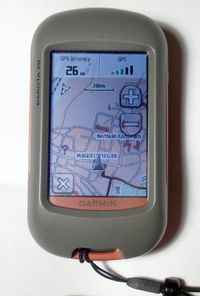Garmin/Dakota series
< Garmin
Jump to navigation
Jump to search
Members of the Dakota device family
Dakota 10
- low cost version of the Dakota 20 with severly cut features
- no compass
- no barometric altimeter
- no ANT+ file transfer, no external sensors possible
- no Micro SDHC card
Links:
- Infos by Garmin (manuals, …)
Dakota 20
Some highlights of the Dakota 20:
- compact, rather heavy, solid feel
- reflective screen visible without backlight in bright sunshine
- usable internal Memory of ~800MB
- additional 1 Micro SDHC card
- PC connection via USB, registers internal and SD card as removable disk drives which means regardless of operating system you can easily copy new data (maps, gpx, waypoints,...) to and from the device.
- Works well with OSM maps (see OSM Map On Garmin) Routable OSM maps are supported and on road routing works just fine (car, cycle, pedestrian mode) You can add more than one map file just by giving it a different name e.g. gmapsupp1.img gmapsupp2.img . No need to merge maps into one file
- maps are initialised right away both from internal and SD card
- touch screen
- Paperless geocaching with gpx files from geocaching.com
- ANT+ wireless data connection (for sensors and data transfer to other Dakota/Oregon)
- profile presets remember the activated maps, enabling fast switching betweens different usage scenariuos including menue layouts, maps, routing settings, ...
Some nuisances:
- The touch screen is rather insensitive to a soft fingertip. A finger nail edge is detected with much less pressure but is somewhat unintuitive. Yet the touch screen may be accidentally activated while the GPS is, for example, carried in a backpack. You may retrieve it only to find new waypoints created and/or settings changed. Protecting the touch screen with thick cardboard may not be sufficient. The Dakota needs a "lock" screen that only unlocks through a specific, complicated gesture.
- screen is rather narrow and scrolling along the short on the touch screen can get tiresome quickly (zoom out, scroll, zoom in also)
- Couldn't figure out how to get GPX files on the SD card loaded -- seems to use GPX only from the internal memory so far
- However it is possible to create your own route file (for example) if you copy it to the internal card under Garmin/GPX and follow the naming convention Dakota uses for routes, i.e. "Route_12-JUN-13 142632.gpx". Files with a different naming convention may be silently deleted. Also there seems to be a limit of one route per file, and 50 routes maximum. The XML parser seems weak: one unexpected blank line in a file is enough to make it reject the whole file. Beware that once you copy a Route file to the internal memory, you can't later get rid of it by deleting it. The Dakota seems to "absorb" the routes into an internal location somewhere that is not visible through the USB interface. However you can delete the entire collection of Routes (intentionally or otherwise) from the Dakota's internal memory by deleting any old Route files from Garmin/GPX and uploading a different group of Route files.
- A large number of waypoints can be created by uploading an ordinary .gpx file containing waypoints and naming the file something like Waypoints_20-SEP-13.gpx. This may wipe out any previously defined waypoints.
- Couldn't figure out how to get address search working (tried OSM maps and the Garmin TopoV3 Germany -- city search works mostly, address asks for a state and for whatever state given there is no result).
- geocache icons seem always to be active on the map -- no on/off besides moving the gpx files outside the GPX folder.
Links:
- Infos by Garmin (manuals, …)
